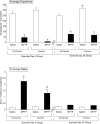Effects of treadmill exercise on dopaminergic transmission in the 1-methyl-4-phenyl-1,2,3,6-tetrahydropyridine-lesioned mouse model of basal ganglia injury
- PMID: 17507552
- PMCID: PMC6672356
- DOI: 10.1523/JNEUROSCI.1069-07.2007
Effects of treadmill exercise on dopaminergic transmission in the 1-methyl-4-phenyl-1,2,3,6-tetrahydropyridine-lesioned mouse model of basal ganglia injury
Abstract
Studies have suggested that there are beneficial effects of exercise in patients with Parkinson's disease, but the underlying molecular mechanisms responsible for these effects are poorly understood. Studies in rodent models provide a means to examine the effects of exercise on dopaminergic neurotransmission. Using intensive treadmill exercise, we determined changes in striatal dopamine in the 1-methyl-4-phenyl-1,2,3,6-tetrahydropyridine (MPTP)-lesioned mouse. C57BL/6J mice were divided into four groups: (1) saline, (2) saline plus exercise, (3) MPTP, and (4) MPTP plus exercise. Exercise was started 5 d after MPTP lesioning and continued for 28 d. Treadmill running improved motor velocity in both exercise groups. All exercised animals also showed increased latency to fall (improved balance) using the accelerating rotarod compared with nonexercised mice. Using HPLC, we found no difference in striatal dopamine tissue levels between MPTP plus exercise compared with MPTP mice. There was an increase detected in saline plus exercise mice. Analyses using fast-scan cyclic voltammetry showed increased stimulus-evoked release and a decrease in decay of dopamine in the dorsal striatum of MPTP plus exercise mice only. Immunohistochemical staining analysis of striatal tyrosine hydroxylase and dopamine transporter proteins showed decreased expression in MPTP plus exercise mice compared with MPTP mice. There were no differences in mRNA transcript expression in midbrain dopaminergic neurons between these two groups. However, there was diminished transcript expression in saline plus exercise compared with saline mice. Our findings suggest that the benefits of treadmill exercise on motor performance may be accompanied by changes in dopaminergic neurotransmission that are different in the injured (MPTP-lesioned) compared with the noninjured (saline) nigrostriatal system.
Figures







References
-
- Bezard E, Dovero S, Imbert C, Boraud T, Gross CE. Spontaneous long-term compensatory dopaminergic sprouting in MPTP-treated mice. Synapse. 2000;38:363–368. - PubMed
-
- Bezard E, Dovero S, Belin D, Duconger S, Jackson-Lewis V, Przedborski S, Piazza PV, Gross CE, Jaber M. Enriched environment confers resistance to 1-methyl-4-phenyl-1,2,3,6-tetrahydropyridine and cocaine: involvement of dopamine transporter and trophic factors. J Neurosci. 2003;23:10999–11007. - PMC - PubMed
-
- Brown LL, Sharp FR. Metabolic mapping of rat striatum: somatotopic organization of sensorimotor activity. Brain Res. 1995;686:207–222. - PubMed
-
- Burke RE, Cadet JL, Kent JD, Karanas AL, Jackson-Lewis V. An assessment of the validity of densitometric measures of striatal tyrosine hydroxylase-positive fibers: relationship to apomorphine-induced rotations in 6-hydroxydopamine lesioned rats. J Neurosci Methods. 1990;35:63–73. - PubMed
Publication types
MeSH terms
Substances
Grants and funding
LinkOut - more resources
Full Text Sources
